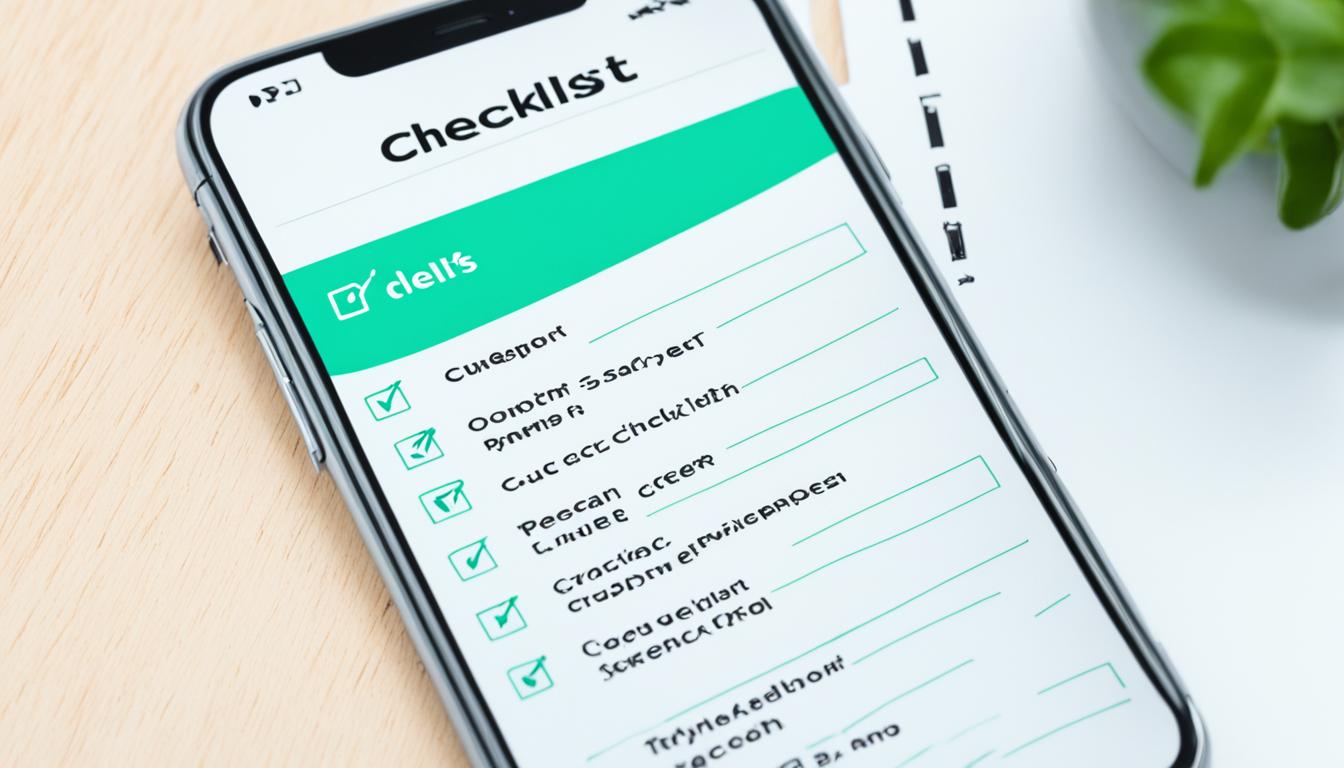For those managing real estate assets, efficiency is crucial. A property management maintenance checklist template is fundamental. It ensures all areas are inspected thoroughly. This essential maintenance checklist streamlines operations and serves as a concise guide, preventing any oversight.
By simplifying property maintenance complexities, technical property managers can focus more on enhancing portfolio value. They won’t be bogged down by the demands of maintaining property conditions. A well-crafted checklist supports simplified property management goals: being thorough, maintaining standards, and a proactive property care approach.
Key Takeaways
- A checklist template is crucial for thorough and regular property inspections.
- Maintaining property conditions is easier with a structured maintenance approach.
- Checklists serve as a proactive measure to reduce future costs and improve efficiency.
- Adapting the checklist to the specific demands of the property is important for thorough maintenance.
- Using a checklist can help in delivering higher tenant satisfaction and retention.
- Efficient checklists aid in ensuring safety compliance and regulatory adherence.
The Importance of Regular Property Maintenance
Maintaining a rental property’s structural integrity is critical for lasting business success. Regular, planned maintenance can greatly extend property longevity and enhance tenant satisfaction. Implementing a rental property maintenance schedule ensures that properties remain livable, safe, and appealing. This strategy is essential for maximizing the investment’s value over time.
Why Maintenance Matters for Property Longevity
All properties eventually show signs of wear and tear. Regular maintenance is key to combating this decay, thus preserving property longevity. Well-maintained properties face fewer large-scale repairs, saving both time and money. Addressing small issues promptly through regular check-ups prevents them from escalating into major problems.
Impact of Maintenance on Tenant Satisfaction
Tenants value the condition of their rental space as much as its location or design. Properly maintained properties reflect the management’s commitment to tenant satisfaction. Promptly addressing maintenance concerns builds trust between tenants and managers. This trust encourages tenants to renew their leases, reducing vacancies and stabilizing rental income.
Adhering to a regular rental property maintenance schedule benefits both the property’s physical state and its business success. It fosters a balance that aligns with the objectives of property and asset managers.
How Checklists Elevate Property Management
The cornerstone of sustaining any property’s value and functionality lies in consistent upkeep. In the realm of property management, nothing is more crucial than the implementation of a solid property maintenance inspection template. Such a template is not merely a document; it’s the blueprint for operational excellence. It ensures that all aspects of property care are carried out with checklist efficiency, minimizing room for error and maximizing the effectiveness of routine checks.
Technical Property Managers and Technical Asset Managers are well aware that the consistent effort to maintain property condition can be made more manageable by checklists that detail necessary tasks for different parts of the property. Whether tracking the state of the electrical systems or ensuring that the landscape is well-manicured, a checklist functions as a critical aid for these professionals to manage responsibilities that do not involve ownership of the property.
- Regular inspections highlighted in checklists identify minor issues before they escalate into costly repairs.
- Checklists can be tailored to seasonal needs, emphasizing relevant maintenance tasks at appropriate times.
- They provide a clear structure for staff to follow, promoting consistency and thoroughness.
Introducing a checklist into property management is less about ticking off completed tasks and more about instilling a disciplined approach to maintenance. It lays out a systematic path that, when followed, reduces the likelihood of overlooking crucial details that could lead to deterioration of a property.
To illustrate the property maintenance inspection template in action, see the detailed checklist below. It encompasses a range of inspection points that cover both the interior and the exterior of the property, solidifying the maintenance process from the ground up and leaving no stone unturned.
| Internal Inspection Items | External Inspection Items |
|---|---|
| 1. Check smoke detectors and fire extinguishers | 1. Inspect roofing for potential damage |
| 2. Test all electrical outlets for proper functioning | 2. Clean gutters and downspouts |
| 3. Evaluate the condition of flooring and ceilings | 3. Examine the foundations for cracks or signs of moisture |
| 4. Look for signs of pest infestations | 4. Ensure that landscaping does not threaten property structures |
| 5. Service heating and cooling systems | 5. Review the condition of paint and façade |
Deploying such a comprehensive inspection checklist ensures that property maintenance is conducted with an eye for detail and an overarching goal of preservation. The balance struck between precaution and action via these lists embodies the ethos of checklist efficiency: a proactive stance on maintenance that results in the retaining of value and functionality of real estate assets.
Seasonal Maintenance Planning: A Bi-Annual Approach
Every season brings unique weather challenges, making seasonal planning essential for commercial real estate upkeep. A robust commercial property maintenance checklist is crucial. It prepares the property to face any weather condition. This approach not only prolongs the building’s life but also maintains its functionality and appearance all year.
An effective maintenance plan surpasses usual tasks by incorporating bi-annual maintenance aligned with significant seasonal changes. This strategy focuses on preventing problems before they occur, rather than just responding to them after the fact. To organize your bi-annual maintenance effectively, here’s a structure to follow:
- Spring/Summer: Examine outdoor areas for winter wear. Repair roofs, pavements, and signs. Prep for more visitors.
- Fall/Winter: Winter-proof plumbing, check heating, and ensure proper insulation for energy savings.
| Season | Checklist Focus Area | Maintenance Actions |
|---|---|---|
| Spring/Summer | Exterior Maintenance | Inspect roof, clear gutters, test outdoor lighting, prep landscaping for growth |
| Fall/Winter | Interior Comfort | Check heating systems, winterize irrigation, assess weather stripping and insulation |
This seasonal planning is crucial within a larger, year-round commercial property maintenance checklist. It ensures the property stays in top shape, no matter the weather.
Creating Your Property Management Maintenance Checklist Template
For property managers, the successful upkeep of a property hinges on meticulous organization and attention to detail. Developing a comprehensive residential property maintenance checklist ensures all aspects of a property receive the necessary care to maintain high standards. With the creation of a property maintenance planner template, managers can keep track of every task, whether it’s for a residential dwelling, a commercial complex, or a quaint vacation rental. Here we’ll explore the critical task of custom checklist creation that caters specifically to the nuances of each property type.
Internal Vs. External Maintenance Tasks
Understanding the difference between internal and external maintenance is the first step in custom checklist creation. Internal maintenance may include tasks such as inspecting HVAC systems, checking smoke detectors, and ensuring plumbing is in good working order. Meanwhile, external maintenance often covers areas like lawn care, roof inspections, and external paint touch-ups. Every property requires a tailored approach to these tasks to ensure proper maintenance and management.
Customizing Your Checklist to Property Type
The nuances between different property types call for a unique approach to maintenance planning. For a residential property, a property manager may prioritize daily functionality and comfort, focusing on aspects like heating, pest control, and safety equipment. Whereas for a commercial property, the checklist may involve regulatory compliance and maintenance of shared spaces. A customizable template enables a personalized approach to each property, ensuring that nothing falls through the cracks.
| Residential Properties | Commercial Properties |
|---|---|
| Pest control services | Fire safety equipment checks |
| Regular HVAC maintenance | Elevator inspections |
| Smoke and CO detectors testing | Common area cleaning schedules |
| Gutter cleaning | Compliance with accessibility regulations |
| Functionality check of home appliances | Structural inspections |
Optimizing Tenant Turnovers with a Checklist
For rental property managers, tenant turnover is key. It’s the gap between occupancies. This time is crucial for improving the property for the next tenant. A tenant turnover checklist is essential for this phase. It reviews and maintains all property aspects. Plus, it evidences the property’s condition, smoothing future rentals.
To create an effective tenant turnover checklist, think carefully. It must be detailed but practical. The goal is to keep the property in top shape and maintain high occupancy rates. A good checklist enables faster unit turnovers. This ensures tenant satisfaction and keeps the property desirable.
A well-crafted checklist covers everything. From minor repairs to deep cleaning, nothing is missed. Such meticulousness cuts downtime between tenants. It also sets a quality standard in competitive markets.
- Inspect and re-caulk bathroom fixtures to prevent moisture damage.
- Ensure all lights are operating correctly and replace any burnt-out bulbs.
- Test and replace batteries in smoke detectors and carbon monoxide alarms.
- Check for any leaks under sinks and in appliances like dishwashers and washing machines.
- Tighten loose hardware on doors, cabinets, and windows to ensure everything is secure.
- Document current property conditions with clear photos for records and future reference.
- Perform professional carpet cleaning to revitalize flooring and improve the unit’s overall appearance.
Completing the tenant turnover checklist reduces maintenance issues. This is crucial for keeping tenants long-term. Such proactive management upholds quality. This makes a property stand out in a competitive market.
Let’s view a table of a standard tenant turnover checklist:
| Maintenance Task | Description | Status |
|---|---|---|
| Re-caulking | Applying fresh sealant to areas prone to moisture, such as bathtubs and sinks. | Complete |
| Fixture Tightening | Securing loose elements such as knobs, handles, and hinges. | Complete |
| Smoke Detector Check | Testing alarm systems and replacing batteries or units if necessary. | Complete |
| Utility Inspection | Verifying the functionality of water, gas, and electrical systems. | Complete |
| General Cleaning | Deep cleaning the property to ensure a welcoming space for new tenants. | Complete |
| Property Condition Documentation | Taking photos and detailed notes of the property’s status prior to a new tenancy. | Complete |
In sum, using a refined tenant turnover checklist in their strategy helps managers significantly. It optimizes turnovers and maintains rentals in top condition. This ensures quick, smooth transitions between tenants.
Tips for Effective Maintenance Scheduling
Maintaining a property demands detailed planning and strategic organization. Efficient oversight of maintenance keeps the property top-notch. It boosts tenant happiness and ensures operations run smoothly. A smart strategy for maintenance scheduling is crucial. Here, a property maintenance work order template proves invaluable. It steers the maintenance crew correctly, ensuring they tackle issues timely. This boosts the care quality for the property.
Using maintenance software helps property managers streamline work orders. It shifts routine tasks off the phones, enhancing call center efficiency. This lets them respond to tenant requests faster and more accurately. This division of work changes maintenance request handling, eases staff workload, and betters tenant experiences with quick services.
A systematic upkeep schedule, supported by clever software, is key for smooth property management. It ensures urgent matters get swift attention and routine tasks are well-timed. An organized approach helps balance proactive and reactive maintenance tasks. This way, urgent fixes don’t overshadow regular upkeep.
To encourage proactive scheduling, here is a basic overview of a work order template for property managers:
| Work Order ID | Description | Priority Level | Scheduled Date | Assigned To | Status |
|---|---|---|---|---|---|
| WO101 | Inspect and repair leaking roof | High | 05/01/2023 | Maintenance Team A | Pending |
| WO102 | Annual HVAC System Check | Medium | 05/15/2023 | Vendor: CoolAir Inc. | Scheduled |
| WO103 | Routine landscaping services | Low | Every 2nd Monday | GreenScapes LLC | Ongoing |
| WO104 | Exterior painting and touch-ups | Medium | 06/05/2023 | Maintenance Team B | Approved |
Utilizing a structured template for work orders has many benefits. It outlines future maintenance tasks clearly and sets clear expectations for teams. A visual plan of scheduled tasks helps property managers maintain high standards. This approach leads to happier tenants and, ultimately, enhances property value.
Best Practices for Property Maintenance Record-Keeping
Efficient property management relies on flawless record-keeping. In property management’s intricate realm, a property maintenance checklist excel is vital. It ensures comprehensive coverage, avoiding missed details. These methods also enhance compliance, maintaining unsurpassed organization crucial for top-tier property upkeep.
Advantages of a Property Maintenance Log Template
A property maintenance log template stands as a managerial keystone. It lessens mistakes and provides a clear maintenance narrative. This tool is invaluable for high-standard operations. It stresses preventive care and documents repairs, keeping properties in peak condition while tracking compliance.
How to Utilize a Property Maintenance Planner Template
Utilizing a property maintenance planner template boosts preventive strategy and legal compliance. It underpins task delegation and scheduling, smoothing workflow. Task consolidation in one, often digital, space elevates productivity. It simplifies property maintenance’s intricate dynamics.
| Task | Frequency | Last Completed | Notes |
|---|---|---|---|
| Fire Safety Equipment Check | Monthly | 04/12/2023 | Replaced batteries in smoke detectors |
| HVAC System Inspection | Bi-Annually | 03/20/2023 | Filters changed, system efficiency confirmed |
| Plumbing Inspection | Yearly | 02/25/2023 | No issues detected |
| Roof and Gutter Clean Up | Bi-Annually | 04/15/2023 | Cleared debris post-winter season |
Property Maintenance Inspection: Ensuring Safety and Compliance
Inspections are vital for maintaining safety compliance and regulatory adherence. A detailed property maintenance inspection checklist equips managers to conduct thorough assessments. They embody diligence and show a commitment to occupant safety and property integrity.
The checklist is a roadmap during inspections. It covers components like electrical systems and fire safety. Each part is reviewed to find deviations from standards. Thus, inspections foster a culture of proactive maintenance over reactive solutions.
An example of how to format a checklist includes:
| Inspection Area | Details to Check | Compliance Notes |
|---|---|---|
| Electrical Systems | Check for exposed wiring and test GFCI outlets | Ensure adherence to electrical codes |
| Fire Safety Equipment | Inspect fire extinguishers, alarms, and sprinkler systems | Verify equipment is in working order and meets regulations |
| Structural Elements | Assess foundations, roofing, and building envelope for damage | Record any deterioration or potential hazards |
| HVAC Systems | Ensure heating and cooling systems are fully operational | Check for efficiency compliance standards |
| Accessibility | Evaluate ramps, lifts, and handrails for accessibility | Confirm alignment with ADA requirements |
The checklist is dynamic, reflecting changes in safety compliance and regulation. For property managers, thorough inspections prevent severe problems and costly repairs. It fosters a property maintenance approach that is both responsible and reassuring.
Property Maintenance Checklist Excel: Organizing with Digital Tools
Digital tools have transformed property management, offering solutions like maintenance planner templates and efficiency systems. These are essential for property managers and asset managers, enhancing real estate management.
Efficiency through Property Management Software
Property management software is a game-changer, leveraging technology to simplify maintenance tasks. It allows seamless handling of repair requests and vendor assignments. It also tracks maintenance activities meticulously. By automating workflow and centralizing data, it boosts maintenance efficiency, saving time and resources for managers.
Tracking and Reporting with Spreadsheet Templates
Property maintenance planner templates, especially in Excel, enable managers to track finances and maintenance history. These templates are crucial for customization. They allow tailoring to specific property needs, tracking various financial and tenant-related data.
The table below shows the features property managers might consider when choosing between software and Excel templates:
| Feature | Property Management Software | Excel Spreadsheet Templates |
|---|---|---|
| Customization | Predefined Templates | Highly Customizable Layouts |
| Data Management | Centralized Database Management | Decentralized with Manual Input |
| Integration | High Integration with Other Digital Tools | Limited to File Sharing and Data Import/Export |
| Accessibility | Cloud-Based Access from Any Location | Dependent on Local Storage or Shared Drives |
| Cost | Subscription-Based Model | One-Time Purchase or Free Versions Available |
| Real-Time Updates | Immediate Synchronization Across Platforms | Updates Require Manual Revision |
Both digital tools offer unique advantages for property maintenance management. Property managers can choose between sophisticated software for workflow optimization or customizable Excel templates for flexibility, enhancing maintenance control and efficiency.
Commercial Property Maintenance Checklist for Business Facilities
A fundamental tool for property managers is a commercial property maintenance checklist. It boosts business facility upkeep by merging enterprise-level management proficiency. It covers maintenance tasks vital for preserving property functionality and aesthetic appeal. Additionally, it supports uninterrupted business activities.
This checklist must cover both inside and outside maintenance demands unique to commercial buildings. It includes examining shared spaces, emergency systems, HVAC units, and following safety and accessibility standards. To ensure these tasks are managed properly, the checklist needs to be detailed, comprehensive, and straightforward.
- Inspect and maintain roofing and drainage systems to prevent water infiltration
- Check the integrity and operation of windows and exterior doors
- Regularly clean and maintain the property’s facade and parking areas
- Assess the condition of sidewalks and other walkways for safety
- Verify that landscape and outdoor lighting contribute to the property’s security and aesthetics
- Conduct scheduled inspections and servicing of elevator and escalator systems
- Examine fire safety equipment, ensuring that alarms, extinguishers, and sprinkler systems are in working order
- Review and test HVAC systems for efficiency and air quality
- Guarantee that plumbing facilities are operational and leak-free
- Enforce pest control measures to maintain a hygienic environment
- Establish procedures for waste disposal and recycling in line with sustainability practices
- Check accessibility features for compliance with ADA standards
Below is an example commercial property maintenance checklist segment. It promotes a proactive posture in business facility upkeep:
| Checklist Item | Frequency | Responsible Party | Notes/Status |
|---|---|---|---|
| Fire safety equipment inspection | Monthly | Facility Manager | Ensures compliance with local fire codes and operational safety |
| HVAC filters replacement | Quarterly | Maintenance Crew | Central to air quality and system efficiency |
| Accessibility feature audit | Bi-Annually | Compliance Officer | Verification against latest ADA guidelines |
| Landscape maintenance | Seasonally | Landscaping Contractor | Includes mowing, pruning, and plant health assessments |
Through regular, strategic maintenance via a well-designed checklist, managers maintain facilities at a high standard. This approach aligns with enterprise-level management goals. It’s not solely about aesthetics but also about ensuring properties support the success and efficiency of tenant businesses.
Residential Property Maintenance Checklist for Homeowners and Landlords
Maintaining a residential property requires numerous tasks. These enhance its functionality, appeal, and overall value. A well-structured residential property maintenance checklist streamlines these efforts for homeowners and landlords alike. It acts as a guide to preserve the property’s condition, protect investments, and meet landlord obligations.
Addressing Common Residential Maintenance Issues
Regular maintenance is key in handling common residential problems. These include HVAC servicing, plumbing checks, and ensuring electrical system safety. Homeowners should be vigilant for wear and tear signs. It’s crucial that appliances function correctly and the structure remains secure. Landlords bear the extra duty to comply with building codes and maintain tenant living standards. A detailed checklist for homeowner maintenance helps prevent small issues from becoming major expenses.
Maintaining Curb Appeal and Property Value
Curb appeal goes beyond aesthetics. It heavily influences property value and how a home is perceived. Key tasks such as landscaping, painting the exterior, and seasonal clean-up are vital. Homeowners and landlords alike need to regularly perform these tasks. This preserves or enhances property value. It ensures a strong investment return and appeals to potential tenants or buyers.
- Inspect and clean gutters and downspouts
- Check seals around windows and doors
- Test smoke alarms and carbon monoxide detectors
- Service heating and cooling units bi-annually
- Clean and inspect major appliances
- Touch-up exterior paint and trim as needed
- Maintain lawn and garden areas
- Inspect roofing for damage or leaks
- Assess driveway and pathways for repairs
A detailed checklist simplifies residential property maintenance. It reduces the stress on homeowners and meets landlord duties. This attentiveness not only preserves the space but strengthens tenant relationships. It encourages long-term occupancy and enhances tenant satisfaction.
Conclusion
In the realm of property management, being efficient and precise is crucial. A property management maintenance checklist template acts as a guide. It leads professionals through the many responsibilities of property upkeep. This strategic tool simplifies tasks and encourages a proactive stance. It significantly reduces mistakes and boosts property value.
For technical asset managers, this checklist is critical. It helps achieve financial goals through smart investments. It ensures properties meet current safety and maintenance standards. This preserves the integrity and enhances the value of real estate portfolios. The checklist adapts to meet the specific needs of each property. This flexibility is key to addressing the unique challenges of managing both commercial and residential properties.
Digital tools have transformed property management. They stress the importance of an integrated approach to maintenance. These advancements prepare the industry for future challenges. They foster a culture of thorough care and attention to detail. A well-crafted maintenance checklist is essential for reliable management. It ensures properties are maintained excellently, demonstrating a commitment to quality and tenant satisfaction.
FAQ
Why is using a property management maintenance checklist template essential?
A property management maintenance checklist template guarantees all critical tasks are addressed, minimizing errors and omissions. It fosters a systematic approach to maintenance, ensuring properties stay in top condition. This adherence to high standards promotes safety and maintenance efficiency.
How does regular property maintenance impact tenant satisfaction?
Consistent upkeep ensures properties remain secure, functional, and visually appealing. It directly boosts tenant happiness, decreases complaints, and enhances loyalty. Furthermore, well-maintained properties attract new tenants more effectively.
Why are checklists important in property management maintenance?
Checklists offer a methodical framework for property examinations, sustaining a property’s good condition and boosting checklist productivity. They guide property managers to cover every maintenance facet consistently and in depth.
What should be included in a bi-annual seasonal property maintenance checklist?
A seasonal property maintenance checklist for every six months should feature HVAC assessments, gutter cleanings, and roof inspections. It must also include tests on smoke detectors, appliance maintenance, and seasonal landscaping adjustments for upcoming weather changes.
How can I customize my property management maintenance checklist to different property types?
To tailor your checklist, take into account the distinct requirements of various property types. Stress daily maintenance for residential areas, while focusing on compliance and communal area upkeep for commercial properties. Adjust the list according to each property’s specific needs.
What are some key tasks to include during tenant turnovers?
During tenant swaps, include comprehensive cleaning, necessary repainting, and carpet renewal or cleaning in your checklist. Ensure fixture repairs, safety equipment checks, and damage assessments are conducted to maintain excellence.
What are some tips for effective maintenance scheduling?
For efficient scheduling, prioritize pressing concerns. Employ a work order template to organize tasks and appropriately delegate them. Utilize software solutions for keeping track of maintenance requests and for seamless communication with tenants and service providers.
How can a property maintenance log template benefit property management operations?
A property maintenance log template aids in cataloging maintenance activities, repair works, and preventive steps. It bolsters efficient property management and legal compliance, making it simpler to access maintenance history when required.
How does a property maintenance inspection checklist ensure safety and compliance?
A maintenance inspection checklist enables methodical evaluation of a property’s safety mechanisms and structural soundness, ensuring they meet compliance norms. Regular reviews diminish hazard risks and uphold regulatory adherence.
How do digital tools like property management software improve maintenance efficiency?
Digital platforms like property management software optimize the maintenance workflow, facilitating tenant request logging and task completion tracking. They centralize documentation, scheduling, and communication, enhancing efficiency and accuracy in record-keeping.
What makes a commercial property maintenance checklist different from residential ones?
The focus of a commercial property maintenance list includes larger system overhauls, adherence to business regulations, and upkeep of highly-used common areas. Conversely, residential checklists cater to more personal maintenance issues.
As a homeowner or landlord, how can I address common residential maintenance issues?
Utilize a residential property maintenance checklist to routinely inspect and upkeep appliances, HVAC systems, and electrical and plumbing fixtures. Proactive maintenance deters major repairs later, conserving resources and ensuring a stable living environment.






